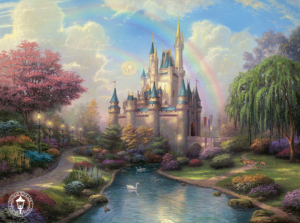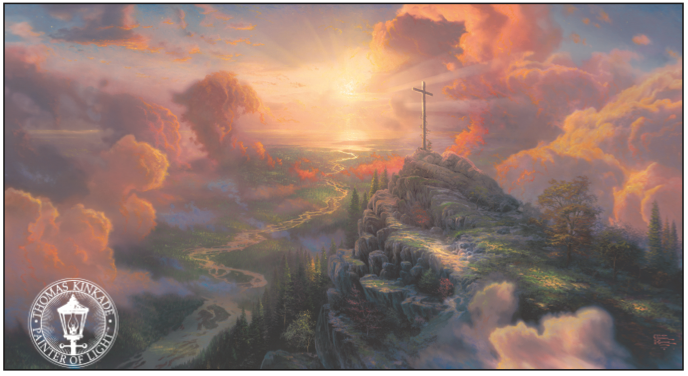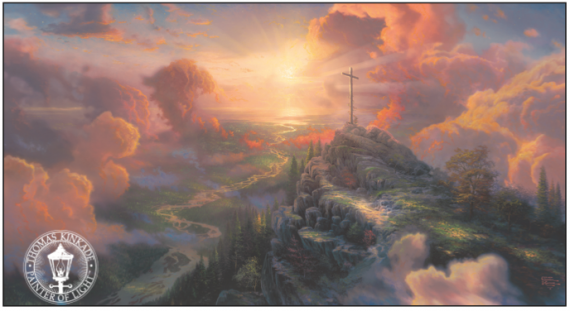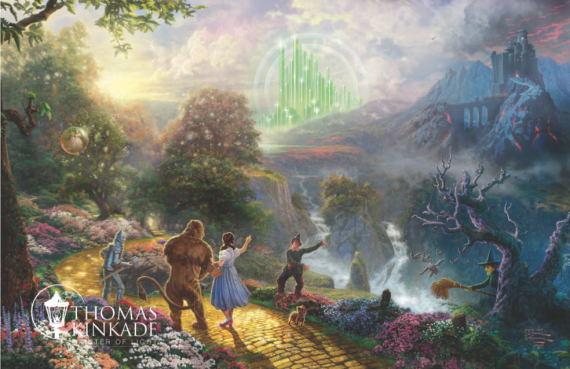I was enjoying a discussion with someone about hyperrealism around the time I wrote last night about my love for the works of Eric Christensen, Pedro Campos, Steve Mills, and Nathan Taylor, when they kept insisting that stil life paintings, particularly those that are close to a photograph, lack emotion. (I completely disagree – the reason I love hyperrealism is because it stirs far more emotion in me than most other genres of art.)
[mainbodyad]But I started thinking about this notion that an “artist” is someone who evokes emotion whereas a “craftsman” is someone who has merely mastered the technical aspects of painting and artistic reproduction. A true artist, they insist, is someone who stirs deep, powerful emotions in the viewer.
I thought about this for a moment and then responded: If that is the measurement of art, as my counterpart insisted, then there can be absolutely no doubt that the greatest artist of all time is … Thomas Kinkade. No, I’m serious. Take a moment to think about it.

Thomas Kinkade art has been turned into far more than just reproductions of paintings. Personally, I don't own any Thomas Kinkade paintings, but there are several Christmas decorations, such as this snowman, that can be found in both my home and office.
It is estimated that Thomas Kinkade art can be found in one out of every twenty homes in the United States. People who otherwise would spend no money on art will spend hundreds, or even thousands, of dollars on reproductions of a Thomas Kinkade painting. They pass them down from family-to-family. They are cherished heirlooms for certain families when parents or grandparents pass away.
People will stand in front of a religiously themed Thomas Kinkade painting, such as “The Cross” (see below), and cry. The art means something to them, often on a very deep, personal level.
The Mental Models Behind the Thomas Kinkade Art Discussion
This entire concept intrigued me. If the art establishment thinks emotional response is the primary driver of a great artist, why did they reject Kinkade’s work? I started pulling articles, essays, and archived newspaper clips. The most common theme was: “He isn’t relevant“.
Seriously!? Whether or not you love or despise the man’s work, whether you think he paints life as it ought to be or he creates sugary-sweet trash, whether you admire his success or resent it, there can be no doubt that in terms of relevance, Thomas Kinkade is the single most relevant artist in the entire history of the world. More people have taken their hard earned money, for which they traded their labor and time, and used it to purchase his work because it meant something to them, than any other artist in human history, both in absolute and relative terms!

Thomas Kinkade further creates emotional bonds by painting subjects, such as the Walt Disney Cinderella Castle, that already have enormous emotional goodwill with audiences.
Whatever he is doing, Thomas Kinkade speaks to approximately 5% of the United States population in a way that other artists do not. I suspect it is part style (the paintings are visually beautiful), part subject matter, part personal story, and part marketing.
One art critic seethed that, “In one hundred years, no one will remember him [Kinkade]”. I almost laughed out loud because I finally figured out what was driving the animus (more on that later). I’ve spent my life making money by looking at trends and trying to determine what will happen so I can profit off of it. If anything, I would say that Kinkade popularity will be far greater a century from now than it is today. The reason is fairly simple: Art critics, much to their chagrin, do not determine the financial value of art. The free market does. Business men, who made their money in donuts and coffee or software and steel, make that decision by “voting” with their dollars. Likewise, workers, taking their hard-earned paychecks, make that decision.
Then, you get into the issue of scarcity. Once Kinkade is gone, the value of his existing works would be more likely to rise as a larger population fought for a fixed amount (and eventually shrinking, since works will be destroyed in fires or through theft) of paintings and reproductions.
The Thomas Kinkade Art Discussion Is About Self-Identity
This apparent blind spot in the art world – saying emotion, not technique alone, is the primary driver of artistic identity – yet then rejecting Kinkade’s work as too emotional – caused me to start searching through the mental model catalog I’ve built up over time. I only got a few into the list when it hit me. It has to be basic, human envy. More specifically, I think it is a combination of the following mental models:
- Basic Human Envy
- Like / Dislike Overreaction Tendency
- Cognitive Dissonance (the Threat to Self-Identity)
My guess is that most of the artists are sitting at home saying, “I could have painted that. And here he is with hundreds of millions of dollars in sales.”
But here is the hitch: They aren’t. These other artists may be capable of doing it, or thinking they are capable of doing it, but none of them have.
It reminds me of the story of singer / songwriter Amy Grant. After making tens of millions of dollars and winning countless awards, one of her contemporaries mocked her saying, “She composes songs like the girl next door.”
Without missing a beat, another contemporary looked at the transgressor and responded. “Yes, but the girl next door isn’t writing these songs.”
Doing vs. Thinking
The point is, being capable of doing something, and doing something, are not the same thing. Love him or hate him, Thomas Kinkade has built an art machine that the artistic world has never seen. He is, in many ways, the Coca-Cola of art; becoming part of the cultural framework of the nation. He is the most relevant artist of all time. If the works of Manet were to disappear, most people wouldn’t notice. If Kinkade was banned, there would be a revolt in the streets. Some people feel about Thomas Kinkade art the same way I feel about a good Steinway & Sons grand piano or the Final Fantasy video game franchise.
[mainbodyad]The “establishment” dismissed Mozart on precisely the same grounds, with almost exactly the same rhetoric. Mozart’s decision to use German librettos, in the language of the common people, was mocked. He was told he used “too many notes” and just wanted to impress working people. He was considered base for playing to the harsh and unrefined. Yet, many individual people adored his work and so it lives on today.
My thesis, that basic human envy is driving some of the dislike for Thomas Kinkade’s work in the art establishment world, is strengthened by the near revelry exhibited by some of his detractors when the artist was arrested for a DUI earlier in the year, which has nothing to do with his body of work.
The same was true when the media mistakenly reported that Thomas Kinkade had gone bankrupt. (The manufacturing firm that reproduces Thomas Kinkade works recently went bankrupt, but not Kinkade himself. His paintings continue to sell without a hitch. The studio will just need to find an alternative way to get the lithographs and other merchandise produced.) Those are examples of extreme like/dislike overreaction tendency, as Charlie Munger put it.
Thomas Kinkade Threatens Self-Identity
I think there is also a bit of denial in the mix. If an artist is starving to death, it means – by definition – that people don’t value his work enough to “vote” for it with pieces of paper they exchange for giving up part of their time and efforts. We call those pieces of paper “money”, of course, but you can tell what a person values by how they allocate their funds. To accept that Kinkade is successful, and rich, and loved, means that they are, by definition, not successful, not valued, and not appreciated in the marketplace.
That means you have some fairly powerful mental models working on both sides of the Thomas Kinkade discussion. For his detractors, what is at stake is their very sense of self-respect and well-being. If Kinkade is art, then the archetype of “the starving artist” or “the unappreciated genius” is a lie.
Author J.K. Rowling went through the same thing. Her Harry Potter series won virtually every award selected by children but for years, the literary world refused to acknowledge her books in any meaningful way. The fact that they are the single most relevant childrens’ franchise in the history of mankind is seemingly unimportant to these “experts”. It really is arrogance of the worst, and ultimately pointless, kind.
But one thing is certain: The art establishment will continue to drip with disdain as they sit, unnoticed and unimportant, in insular circles commenting on what other people have created. They are, in my ways, precisely like the Austrian nobles at court, criticizing Ludwig for his “common” approach to music. No one, it should be pointed out, remembers the names of those nobles. But you can still hear Mozart’s music played in symphony halls throughout the world. J.K. Rowling’s books have still sold more than 300 million copies, and Thomas Kinkade still sits on the walls of 1 out of 20 homes in the United States.





